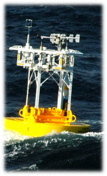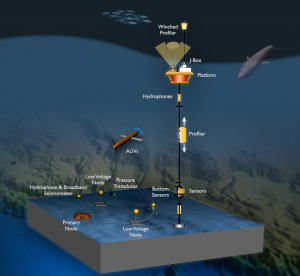Final Network Design
The Final Network Design (FND) was the first baseline document of the OOI, providing the overall conceptual base of the OOI. It was approved through the Final Design Review process conducted by the NSF in 2008.
The below summarizes the major points from within the FND. Note that items within the FND may have been updated as the observatory evolved through design, production, as-built, and deployment. For more information on the configuration of the OOI, please see the Technical Data Package.
 The OOI will transform research of the oceans by establishing a network of interactive, globally distributed sensors with near real-time data access, thereby enhancing our capabilities to address critical issues such as climate change, ecosystem variability, ocean acidification, and carbon cycling. Recent technological advances in sensors, computational speed, communication bandwidth, Internet resources, miniaturization, genomic analyses, high-definition imaging, robotics and data assimilation-modeling-visualization techniques are opening new possibilities for remote scientific inquiry and discovery. The OOI will enable innovative developments across all of these fields and will contribute to maintaining American leadership in scientific advancement as well as providing excellent educational opportunities. The OOI will transform research of the oceans by establishing a network of interactive, globally distributed sensors with near real-time data access, thereby enhancing our capabilities to address critical issues such as climate change, ecosystem variability, ocean acidification, and carbon cycling. Recent technological advances in sensors, computational speed, communication bandwidth, Internet resources, miniaturization, genomic analyses, high-definition imaging, robotics and data assimilation-modeling-visualization techniques are opening new possibilities for remote scientific inquiry and discovery. The OOI will enable innovative developments across all of these fields and will contribute to maintaining American leadership in scientific advancement as well as providing excellent educational opportunities.
Global OOIThe global component of the OOI design includes a network of buoys. These buoys will support sensors for measurement of air-sea fluxes of heat, moisture and momentum; physical, biological and chemical properties throughout the water column, and geophysical observations made on the sea-floor. Such moorings, designed to make interdisciplinary at high interest yet distant sites, are a unique aspect of the global component of the OOI. A network of globally deployed, fixed ocean observatories is designed to contribute to studies of the oceans role in and response to climate change. The Woods Hole Oceanographic Institution, and its partners, Oregon State University and Scripps Institution of Oceanography, is the Implementing Organization (IO) for the Global portion of the system. |
|
|
 (Click to enlarge) Illustration by the University of Washington Regional OOIThe focus of regional scaled ocean observatories is to provide long term and adaptive access to measurements of geological and oceanographic phenomena on regional scales. The regional component will observe processes on a single tectonic plate, using electro-optical cable technology to distribute high levels of power and two-way communication bandwidth to the installed sensors. This will allow for unprecedented real-time interactive and adaptive investigation of a range of physical, chemical, geological and biological processes occurring over space and time scales that are not possible by conventional shipboard operations. The University of Washington is the Implementing Organization (IO) for the Regional Scale. |
|
|
|
|
|
Cyberinfrastructure OOIThe Cyberinfrastructure (CI) component of the OOI provides the common operating infrastructure connecting and coordinating the operations of the three OOI marine components with the scientific and educational pursuits of the oceanographic research communities. This infrastructure will facilitate direct and immediate interaction with the ocean. The CI component will manage observatory resource management, mission command and control, data management and distribution and the meaningful collaboration across a wide range of disciplines. The long term objective is to couple the observation, modeling and mission control systems and make it accessible to all. The University of California, San Diego is the Implementing Organization (IO) for Cyberinfrastructure.
|
|
|

 Coastal OOI
Coastal OOI